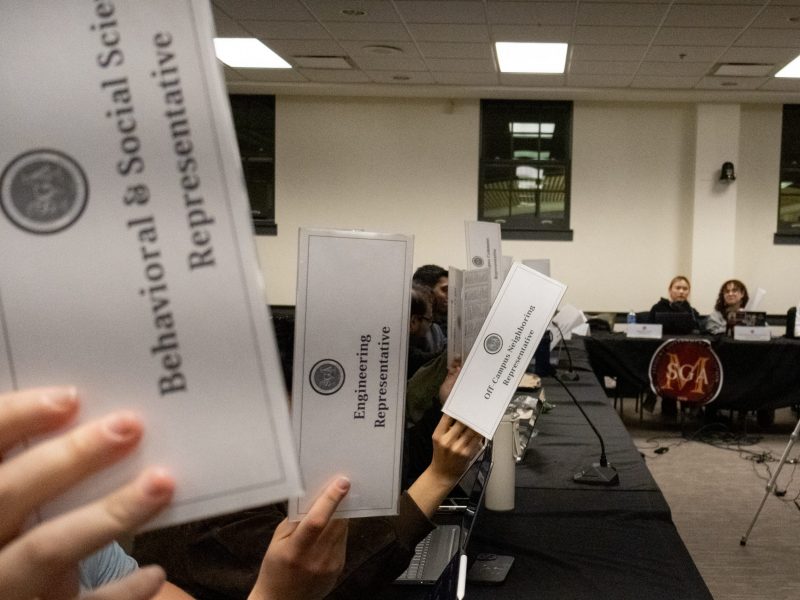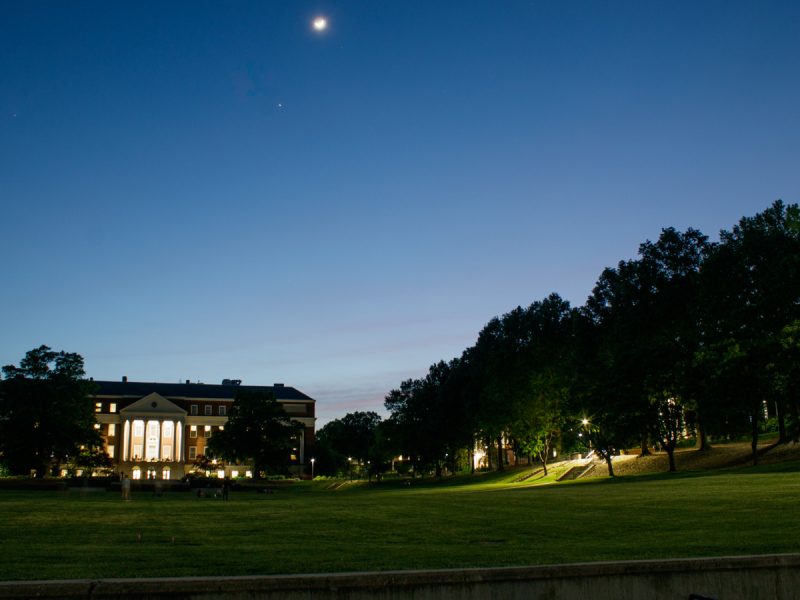By Christine Condon and Danielle Ohl
President Trump plans to defund the National Endowment for the Arts and National Endowment for the Humanities, a move that could jeopardize funding for the arts and humanities at the University of Maryland and in this state.
A Jan. 19 report in The Hill detailed a meeting between White House staff and Trump’s transition team, who fleshed out a plan to cut back on bureaucracy and government spending. The plan included eliminating the two endowments, which have granted this university about $2.5 million for research, performances and projects since 2010.
“[The NEH and NEA] have been important in a lot of ways,” said arts and humanities college Dean Bonnie Dill. “They are a very important part of the work that we do.”
The NEH “promot[es] excellence in the humanities and convey[s] the lessons of history to all Americans” by providing grants to cultural institutions and individual scholars, according to its website. Similarly, the NEA supports arts education via partnerships with state and local institutions. Both agencies were founded in 1965 and collectively account for .006 percent of 2016’s federal spending.
An NEH representative said it would not comment or speculate on the Trump administration’s priorities. The NEA did not respond to request for comment by the time of publication.
The endowments have received criticism from conservative think tanks and pundits for wasting government resources on projects that should be privately funded. But at this university, grant recipients rely on federal funding for work being done in the “true public sphere, not just the elite public sphere,” said Sheri Parks, associate dean of the arts and humanities college.
Parks is the principal investigator of a university grant for Baltimore Stories, a project created to “think alongside Baltimore in the role of narrative and the identity and life of the city” after the 2015 uprisings that followed the death of 25-year-old Freddie Gray. The NEH awarded the program a $225,000 grant in 2016.
“Baltimore was having a very sophisticated conversation with itself,” Parks said. “It was very clear that we didn’t have to be the great scholars to swoop in and teach the public, but could we be useful? Yes, we could be useful.”
Baltimore Stories, which concluded last month, included 20 events within nine months that “facilitated conversation” among working-class Baltimore residents. One event, Parks said, partnered Baltimore teenagers and Baltimore police officers to exchange stories with one another and participate in empathy exercises, where one told the other’s story in the first person. The project also employs a “street crew,” Parks said, to engage working class residents.
The Clarice Smith Performing Arts Center is also supported in part by the Maryland State Arts Council, which has received a recurring grant from the NEA every year since the council’s establishment in the late 1960s, said MSAC executive director Theresa Colvin. MSAC has received more than $5 million in assistance from the NEA since 2010.
The majority of MSAC’s funding is through state appropriation, but federal money helps with the administrative cost of running the arts council and educational programming across the state of Maryland, Colvin said. In 2016, Maryland Gov. Larry Hogan proposed a record-high $20.3 million in appropriations for the Maryland State Arts Council, a $700,000 increase from the previous year.
“Forty percent of the NEA appropriation goes out to state and regional arts agencies,” Colvin said. “We really depend on the National Endowment for the Arts to help meet our expenses here to deliver arts across the state.”
While the grant period for Baltimore Stories runs through July 2017, a new university project centered on migrant youth — coined Home Stories — has a grant period through 2021. If the NEH and NEA are axed, this university and MSAC will likely have to turn toward private donors and philanthropists to supplant federal support, though defunding the entities could affect private support as well.
The Clarice currently receives donor support from organizations such as the Doris Duke Charitable Foundation and the Morris and Gwendolyn Cafritz Foundation.
“There’s usually a match to an NEA grant, and so if they invest in a project, say $20,000, there usually has to be some non-federal source providing $20,000,” said Ken Elpus, a professor in the music school who has been the primary investigator of several NEA grants to this university. “They’ve found a way to take their resources and make sure that the impact of those resources is multiplied.”
Junior David Malamud, an Honors Humanities student, said he is scared for his future career prospects without the NEH but felt that the message being sent to humanities students isn’t altogether different from that of the previous administration.
“The country in general is moving toward emphasizing STEM education and promoting STEM jobs,” the classics, history and Jewish studies major said. “Now, it just seems like this is exacerbated.”
Although university President Wallace Loh has announced his commitment to making this university a STEAM university — adding an “A” for arts to the popular acronym — fewer and fewer students university-wide are opting into humanities degrees. From 2010 to 2015, enrollment dropped by more than 30 percent in the arts and humanities college, which is one of the university’s largest colleges. The college houses 28 majors and 31 minors and receives the third-largest amount of funding of this university’s 11 colleges, trailing behind the business school and the agriculture and natural resources college.
Meanwhile, students have enrolled in STEM-related majors at record rates. Enrollment grew by more than 32 percent in the computer, math and natural sciences college and more than 26 percent in the engineering school between fall 2010 and fall 2015.
Addressing this disparity, ProtectUMD, a coalition of 25 student advocacy groups, included a demand last semester that this university’s administration advocate for and “defend the arts and humanities, as they are one of the departments most sensitive to LGBTQ issues and also one of the most at risk under new state and federal leadership.”
Junior government and politics and history major Aaron Gladstone, an Honors Humanities alumnus, said the NEA and NEH have funded projects that may not have gained a return on their investment, as well as projects those in power may not have liked. They have also highlighted America’s cultural diversity, he said.
“What these programs did is spoke to the variety of American culture, and when you get rid of stuff like this you homogenize American culture into whatever is most dominant.”
The humanities also strive to answer questions that STEM cannot, he added.
“You can’t cure poverty in a test tube,” he said. “The humanities and the social sciences answer the questions that you wouldn’t even think to answer in a science lab.”
Following the news of potential cuts, arts and humanities college department heads were sent an issues brief summarizing reports in The Hill and The Washington Post, Dill said, noting the college will encourage faculty and staff to contact their congressmen and express their concern.
MSAC has not yet considered if and where budget cuts will be made, should the NEA lose funding, and Colvin said she doesn’t know whether The Clarice will feel the effects. She remains hopeful because of this state’s history in supporting the arts as a driver of social and economic growth.
Classics professor and Honors Humanities program director Greg Staley said that the government is responsible for keeping the arts and humanities afloat.
“A democracy is supposed to give voice to the people, and when you can sing, and you can write, when you can dance, you have a way to express what individuals and communities of shared values are feeling and thinking,” he said. “We don’t want to put a stop to that.”



